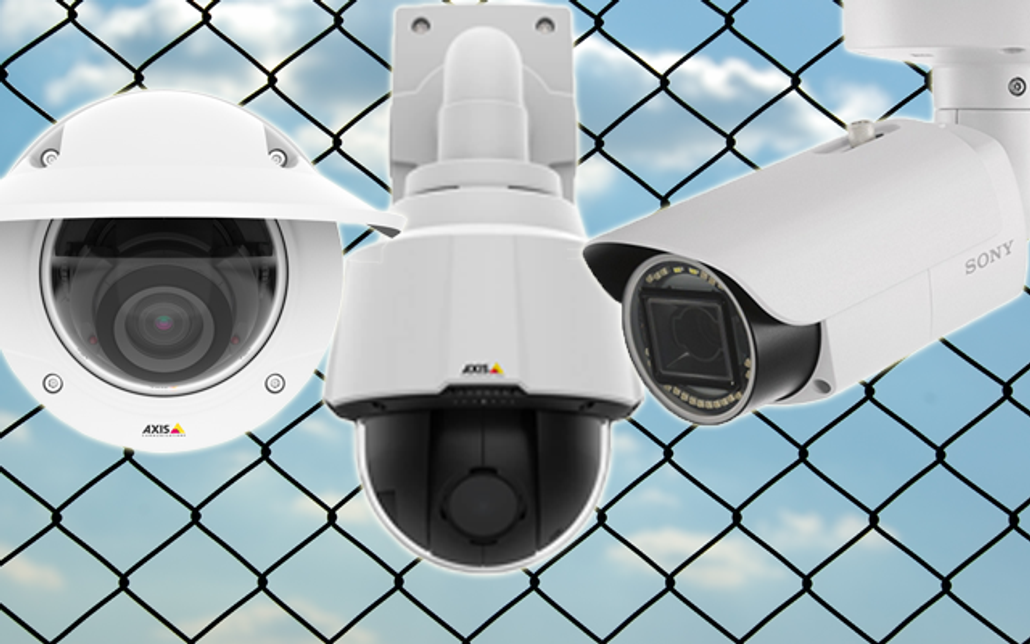Monitoring and protecting a perimeter, be it school grounds or business premises is one of the most common surveillance scenarios. However, with such an array of cameras to choose from, how do you narrow down your options?
This article covers the main features to consider when purchasing cameras to protect a perimeter. Of course, budget is important too, so this guide can help you determine which features are required for your installation.
Do you want to monitor actively or re-actively?
The first aspect to consider is how you're going to monitor, as this can impact the choice of camera.
If you have a security team who monitors feeds and investigates in real time then consider a pan tilt zoom (PTZ). As the name suggests, this camera can zoom and pan to track the movements of an intruder. Most PTZ models offer support for video motion detection, which can be used to move a camera to a preset position once triggered. Some manufacturers, like Axis, offer intelligent features such as Active Gatekeeper which uses Autotracking to follow a subject around the scene.
Alternatively, if your budget is tighter, a fixed-view camera with zooming capabilities can work well. This allows close-up examination into areas of interest within the original image. You have a number of different ways to set up a fixed view system:
Firstly, using digital zoom. Many fixed-view IP cameras offer some form of digital zoom, which allows you to get a close-up of the original image. This is a really handy feature; however, depending on the camera resolution the results can be quite pixilated. Using the digital zoom on a high-resolution (4k) model will give you clearer pictures with less pixelation. The potential downside of this approach is the amount of storage required, though some manufacturers offer bandwidth-reducing technology.
Secondly, you could use a unit with a good optical zoom which enables real-time investigation into areas of interest within the scene. It's worth checking the optical zoom level as the higher the number the further you can zoom in and keep the same picture quality.
Recording round the clock
As perimeter surveillance is 24 hours, how can you ensure your footage is useful in all conditions?
Outdoor surveillance can suffer from challenging light conditions, particularly when your scene contains very bright areas and other sections in shadow. Wide Dynamic Range (WDR) technology balances the dark and light areas of an image to keep both areas visible. WDR is a widespread feature across manufacturers.
Monitoring at night requires true day/night capability which gives you colour images during the day, then black and white images at night. To ensure usable footage when it's very dark then look for a solution with infrared (IR) illumination. IR helps to enhance day/night recording in light levels as low as 0 lux. Many cameras now have IR lights built in, however, external illumination can be added to your network. Take a look at our blog on the pros and cons of inbuilt v external illumination for more details.
Check the how far the illumination will carry, as this can be a guide on how far apart your cameras should be spaced to avoid blind spots at night.
An increasing number of cameras also promise colour night vision. It's worth checking the data sheet to see the conditions this works under. For example if you have a site in a city, then colour night vision would work well as you never have true darkness, though this may not be the case in a rural location.
Thermal cameras can also be a useful addition if your perimeter has obstructions like foliage around it. Thermal detects heat, enabling you to spot a potential intruder faster and from further away. They work particularly well at night and in poor weather conditions.
Final considerations
The field of view is important. Set your field of view so it only contains the areas you need, while giving you enough enough time to spot potential intruders. Too wide a field of view and this uses unnecessary bandwidth. Too narrow and you only have a short time for identification.
Resolution is another key consideration. High resolution gives plenty of detail, but also takes more storage. So this is a case of balancing clarity of image with the amount of storage required. For most scenarios, 3 or 4MP will give you enough detail to see a scene clearly without taking up too much storage.
It's worth checking your shortlist of cameras for which power source they take. Wireless isn't recommended for outdoor recording as the connection could drop out and therefore you could miss footage at a crucial moment. Power over Ethernet (PoE) or 24V power supply are your best choice.
Conclusion
There you have it, by deciding how you're going to monitor your perimeter helps you narrow down the type of camera. Then by considering how you're going to film around the clock can help you choose the right solution for your perimeter.
Now you know what to look for, feel free to chat through your requirements by contacting us.



